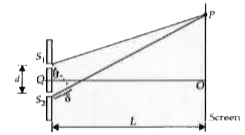In a Young's double slit experiment, (slit distance d) monochromatic light of wavelength λ is used and the fringe pattern observed at a distance D from the slits. The angular position of the bright fringes are
sin−1(Nλd)
sin−1⎛⎜ ⎜⎝(N+12)λd⎞⎟ ⎟⎠
sin−1(NλL)
sin−1⎛⎜ ⎜⎝(N+12)λL⎞⎟ ⎟⎠
The correct Answer is:A

The condition for bright fringes is
Path difference, λ=dsinθbright=Nλ
where N=0,±1,±2,…...
The angular position of the bright fringes is
θbright=sin−1(Nλd)
Topper's Solved these Questions
- BOOK - MTG GUIDECHAPTER - OPTICSEXERCISE - Check your NEET vitals25videos
OPTICS
- BOOK - MTG GUIDECHAPTER - OPTICSEXERCISE - AIPMT/NEET55videos
OPTICS
- BOOK - MTG GUIDECHAPTER - OPTICSEXERCISE - AIPMT/NEET55videos
OPTICS
- BOOK - MTG GUIDECHAPTER - MAGNETIC EFFECTS OF CURRENT AND MAGNETISMEXERCISE - AIPMT/NEET (MCQs)48videos
MAGNETIC EFFECTS OF CURRENT AND MAGNETISM
Similar Questions
Find the angular fringe width in Young's double slit experiment using a monochromatic light of wavelength 500 nm when the slits are separated by 2.5 mm.
View SolutionIn Young's double slit experiment the slits are 0.5 mm apart and interference is observed on a screen placed at a distance of 100 cm from the slits. It is found that the 9th bright fringe is at a distance of 8.835 mm from the second dark fringe from the centre of the fringe pattern. Find the wavelength of light used.
View Solution
Knowledge Check
- Question 1 - Select One
In a Young's double slit experiment (slit distance d) monochromatic light of wavelength λ is used and the figure pattern observed at a distance L from the slits. The angular position of the bright fringes are
Asin−1(Nλd)Bsin−1⎛⎜ ⎜⎝(N+12)λd⎞⎟ ⎟⎠Csin−1(NλL)Dsin−1⎛⎜ ⎜⎝(N+12)λL⎞⎟ ⎟⎠ - Question 2 - Select One
Interference fringes in Young's double slit experiment with monochromatic light are
Aalways equispacedBalways unequally spacedCboth equally and unequally spacedDformed by a portion of the wave front. - Question 3 - Select One
In Young's double slit experiment, the interference bright fringes are of:
Aequal widths and unequal intensitiesBunequal width and equal intensitiesCequal widths and equal intensitiesDunequals widths and unequal intensities
Statement-1: In Young's double slit experiment the two slits are at distance d apart. Interference pattern is observed on a screen at distance D from the slits. At a poit on the screen when it is directly opposite to one of the slits, a dard fringe is observed then the wavelength of wave is proportional of square of distance of two slits.
Statement-2: In Young's double slit experiment, for identical slits, the intensity of a dark fringe is zero.View SolutionIn Young's double-slit experiment, white light is used. The separation between the slits is d. The screen is at a distance D (D » d) from the slits. Some wavelengths are missing exactly in front of one slit. These wavelengths are
View SolutionIn a Young's double slit experiment, light of 500 nm is used to produce an interference pattern. When the distance between the slits is 0.05 mm, the angular width (in degree) of the fringes formed on the distance screen is close to:
View SolutionIn Young's double slit experiment, the two slits are at a distance 'd' apart. Interference pattern is observed on a screen at a distance D front the slit, if at a point on the screen, directly opposite to the slits, the first dark fringe is observed, then wave length of the wave will be
View SolutionIn Young's double slit experiment the two slits are d distance apart. Interference pattern is observed on a screen at a distance D from the slits. A dark fringe is observed on the screen directly opposite to one of the slits. The wavelength of light is
View Solution

